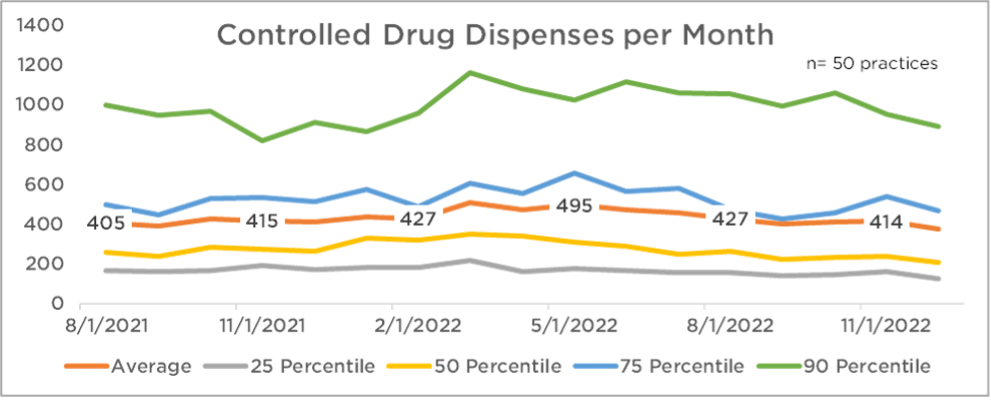
Investing in a Safe Handling Environment
Michael Dahl, MBA
After being introduced to the concept of safe handling, the first question many veterinarians may ask, is, how much will this cost, and how will I recoup those costs? For the first question the answer is, unsurprisingly, ‘it depends;’ the investment in training and technology varies relative to the size of the practice and the scope of the solution. The short(ish) answer is that conversion to a fully compliant Safe Handling environment costs $1-4 per dose administered in practice (or per multi-dose prescription dispensed for home use), with the cost decreasing as the scope of your Safe Handling framework broadens to include dangerous and sensitive drugs alongside controlled substances. If you’d like more details, by all means read on. . .
To fully implement Safe Handling throughout the practice, a number of different elements must be introduced, and all medications that are classified as controlled, dangerous, or sensitive must be actively managed under the framework. This means dedicated training and oversight for the team, a thorough evaluation of existing policies and procedures, and adoption of automated dispensing for physical security and automated tracking of required logs. There are a number of different vendors who can provide solutions that are partially or fully compliant withSafe Handling, so arriving at a conclusive cost estimate, or even a range of what a practice might spend, is surprisingly difficult.
With that in mind, it may be more helpful to begin with the second question, how to recover the costs. Setting a budget for Safe Handling at your practice could be a useful first step towards implementing a better environment for your staff and your patients. The most logical place to begin is volume, or more accurately, the volume of drugs you are dispensing today. Each dose that is administered or dispensed to patients will require some degree of investment, therefore, the aggregate number of doses dispensed is a useful guide for recovering those cost.
One of the first questions that veterinary professionals may ask is how much it will costs to create a Safe Handling environment?
The short answer is as little as $1 per dispense.
Finding the number of doses you dispense today could be surprisingly difficult. You might be tempted to look at your PIMS, but it’s likely that you’re missing quite a few doses due to missed charges. Purchase records can be helpful, but because dosing tends to vary based on weight, it can de challenging to know just how many patients were treated with a 10mg vial of bupenorpherine.
As the largest (although not the only) provider of automated dispensing solutions in the animal health space, CUBEX has a substantial dataset in this space. By analyzing blinded dispense data in partnership with ezyVet from a dataset of joint CUBEX-ezyVet accounts, we were able to glean some very useful insights about just how often a veterinarian can expect to use these drugs, and therefore how much to budget for a Safe Handling program. There were three categories of medications examined for this analysis, as these are the items generally stored in automated dispensing cabinets within the treatment area (as distinct from the pharmacy) of a small animal practice :
Controlled Substances—these are substances governed by CFR 21 and whose storage, use and records are subject to the purview of the DEA
Drugs of Concern—also known as Dangerous Drugs, this category includes substances like Gabapentin and Xylazine that, while not federally controlled, are increasingly subject to state oversight amidst increasing potential for abuse. It can also include medications (mostly injectables) that are neither controlled nor ‘dangerous’ but are at a high risk of revenue loss, and prescription pads. A more comprehensive list of these medications can be found in the white paper.
Controlled Substances
CUBEX Mini is CUBEX’s smallest automated dispensing cabinet, and is used almost exclusively for controlled substance management. By looking at Mini users within the dataset, we can isolate controlled substance dispenses.
Assuming a monthly cost of $750 per month for a Safe Handling environment (technology, training, and assessment), a low-volume practice at the 25th percentile of dispense volume could completely offset that cost with a $4 per dispense Safe Handling fee, or some equivalent form of revenue increase. For an ‘average’ practice in terms of dispense volume, the fee could be around $2.
Adding Drugs of Concern
By broadening the scope of analysis, we can look at the financial impact of wrapping additional inventory items into the Safe Handling framework, notably drugs of concern. Since the number of fee-bearing dispenses will necessarily rise given the increase in the number of items managed, the fee required per dispense decreases substantially. The 110 practices examined for this segment of the analysis uses the CUBEX MiniPlus, a larger-capacity automated dispensing unit that can accommodate the full volume of controlled substances as well as drugs of concern for most practices.
With drugs of concern under management, the average practice can implement a Safe Handling fee of $1 and fully cover the cost of creating a Safe Handling environment, even when accounting for the added expense of higher capacity. For lower-volume practices in the 25% percentile, the figure would need to be closer to $2. Relative to other fees in most practices, a $1 or $2 fee, even multiplied across three or four different drugs administered for a given patient, is unlikely to materially increase the cost of care. In animal health today, the average client charge for procedures when these drugs are used is over $300, so these fees will likely constitute a less than a 1% increase .
Examining practice size as a factor
Most practice owners/operators are unlikely to know which quartile of dispense volume they fall within, so choosing a sufficient fee might be difficult. With number of DVMs on staff serving as a somewhat effective proxy for overall practice service volume, we can take a glimpse at what volume looks like for controlled drugs + drugs of concern based on practice staff size:
Based on the ‘cut’ of the data, it becomes clear that even smaller practices dispense sensitive medications at a relatively high volume, sufficient to offset safety costs with a fee in the $2-3 range. Larger practices tend to need more equipment and training in order to achieve a Safe Handling environment, but even with those increased costs a fee of $1 or so is a reasonable way to recoup any necessary investment.
To put it simply, costs for training, technology or regular tests/mock audits should not be an issue for practices that are willing to implement some form or added revenue around the drugs being managed. In order to keep the per-item fee as low as possible (and to fully comply with Safe Handling protocols), gabapentin and other ‘Drugs of Concern’ should definitely be included in the protocol. With that scope, the per-dispense fee should usually be able to work at just $1. For controlled substances only, the fee may need to be closer to $3 in order to be truly cost-neutral, but even that fee will not have a material impact on the cost of care.
Please note: For any clients who have questions about Safe Handling fees and why these costs have been added to their statement, there are client communication materials and practice staff training available directly from this website.





